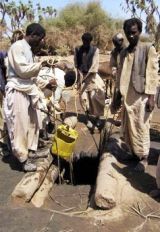Eastern Sudan, the neglected crisis
June 7, 2006 (KASSALA, eastern Sudan) — Helicopter gunships and a humanitarian crisis greet the few Westerners who make it to Kassala, an eastern Sudanese town far from the infamous Darfur region where analysts say a bad situation could be about to get worse.
 With international media and aid groups focused on war-torn Darfur in the west, restrictions on journalists and humanitarian workers travelling to the east mean that a crisis in many ways worse than Darfur’s goes largely ignored.
With international media and aid groups focused on war-torn Darfur in the west, restrictions on journalists and humanitarian workers travelling to the east mean that a crisis in many ways worse than Darfur’s goes largely ignored.
The crude mortality rate for this desert region, shimmering in the June heat and punctuated by towering rock formations rising dramatically from the arid land, is almost double that of Darfur.
There, 14,000 aid workers have been deployed to cope with the humanitarian crisis, but only a tiny fraction of that number work in the east, home to yet another Sudanese rebellion.
A study carried out last year found that acute malnutrition in the east stood at around 19 percent, well-above the emergency level of 15 percent. In Darfur the figure was less than 12 percent.
An AFP correspondent swiftly obtained a permit to visit Darfur but had several applications to travel east refused by Khartoum and only managed to make it in thanks to a World Food Programme humanitarian flight.
“The east is one of the least served areas (of Sudan),” the International Crisis Group’s Suliman Baldo said. “There are a lot of restrictions on NGOs in the east, not like in Darfur.
“The humanitarian needs are not receiving any attention so therefore it’s a bad situation. It definitely needs to be highlighted … the lack of media attention is also responsible.”
A recent report by international NGOs working in the region said: “Eastern Sudan has not been a priority for international and domestic humanitarian and political actors, leaving the population there … extremely under-served.”
Chronic poverty and neglect by the authorities prompted the region’s largest ethnic group, the Beja, to take up arms against Khartoum in 1996, eventually forging an alliance with the much larger, southern-based Sudan People’s Liberation Movement (SPLM).
In 2004, having formed a new alliance with another marginalised minority, the Rashidiya Arabs, to create the Eastern Front, the Beja vowed to escalate their attacks from the rebel-held town of Hamesh Koreb, just north of Kassala.
Khartoum’s suppression of a peaceful demonstration organized by the rebel Beja Congress in the main eastern city of Port Sudan last year left at least 20 people dead, further fuelling radicalism in the region.
While the port city’s trade has made the surrounding Red Sea State one of Sudan’s richest, the wealth does not filter down to the area’s nomads and small farmers. Per capita income by household is less than 100 dollars a year.
Now, with the well-armed SPLM due to withdraw its forces under the terms of a peace deal it signed with Khartoum early last year, there is a growing fear that government forces will soon move in to wipe out the Eastern Front.
Aid workers fear civilians will bear the brunt of any such offensive, further exacerbating the humanitarian crisis.
“Increased instability will have an impact on the already fragile humanitarian situation in the region,” said Barabara Manzi of the UN’s Office for the Coordination of Humanitarian Affairs.
With long-delayed peace talks between the Eastern Front and the government due to be held in neighbouring Eritrea next Tuesday, and with SPLA forces saying they will leave the rebel-held enclave by the end of the month, the timetable is tight.
Failure could have implications for the whole of Sudan not just the the two eastern states.
Port Sudan is the country’s economic lifeline and almost all foreign trade passes along the highway connecting it with the capital through Kassala. Sudan’s newfound oil wealth is also dependent on a vulnerable pipeline that terminates in the port.
Red Sea and Kassala states already count some 160,000 people left homeless by the fighting, on top of around 170,000 refugees from Eritrea.
Toglay camp, just outside Kassala, is home to 6,000 villagers who fled fighting in and around Hamesh Koreb three years ago, and the arrival of a WFP humanitarian convoy is greeted by a crowd of Beja men waving their swords in the air in welcome.
The WFP has recently resumed food aid deliveries to the area, suspended for two months because of government restrictions, but the people here say they still lack medicine and education, and dream of the land and livestock they left behind.
Pending their return, the WFP works with local and international charities to provide education to the women of this conservative Muslim region as well as ways to earn a livelihood such as cooking and basket weaving.
“There is no problem educating the women, provided it doesn’t interfere with their housework,” said the WFP’s Daifalla Adam.
(ST)
